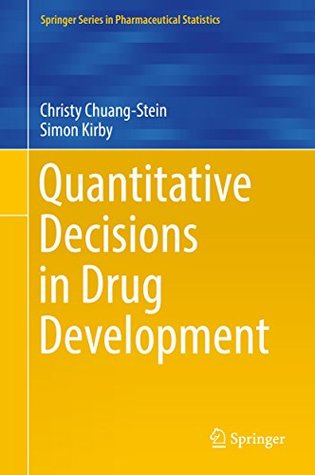Read Quantitative Decisions in Drug Development (Springer Series in Pharmaceutical Statistics) - Christy Chuang-Stein | PDF
Related searches:
The need for more cost-effective and more efficient drug development is widely recognized but largely unmet.
Is the employer trained and qualified to make any decisions from the quantitative levels? many factors influence the level of a drug in a donor’s system. Metabolism, physical condition, fluid balance, frequency of drug ingestion and the last time the drug was consumed are all contributing factors to quantitative levels.
A quantitative approach for making go/no-go decisions in drug development.
Themed section: incorporating patient preferences into regulatory decision making in benefit-risk assessments during the drug life cycle (prefer) project.
The quantitative pharmacology network is the “go to” voice for the application of quantitative pharmacology to drug/biologics development and usage, and catalyzes broader awareness, education and adoption of these principles by scientists engaged in the complementary networks.
Serial creatinine- corrected quantitative values may assist in the differential assessment of ongoing drug use or cessation of drug use with continued drug excretion. If the test drug is not volatile, it must be modified or derivatized to a volatile form.
The quantitative decision-making special interest group (qdm sig) was formed in october 2017. It is a group of statisticians from industry and academia, with experience and interests in statistical methods for quantitative decision-making in drug development.
Quantitative decision criteria mbdd activities should begin with defining target values and criteria for decision making. These criteria should be stated as explicitly as possible and discussed by governance committees responsible for making drug development decisions.
Quantitative systems pharmacology (qsp) is a mathematical modeling and and impacted critical decisions, in the continuum from preclinical exploration to clinical to provide quantitative guidance for their drug discovery and devel.
The concept of “ quantitative pharmacology ” relies on their use for making decisions on the future of the drug candidate, by increasing the understanding of its action, and the expected benefit/risk profile in the target patient population.
Specific / quantitative target product profile (tpp) • model-based quantitative analyses enhance ability to make these decision • addresses the balance between safety and efficacy and other key risks through specific mitigation planning • impact is also a key driver in the decision making process.
The bayesian paradigm is often chosen for decision making in clinical development due to its probabilistic statements around parameters. These probability statements are visually depicted through prior and posterior distributions, distribution estimates of an unknown quantity of interest, and are powerful tools for visualizing and pooling prior information and expert opinion with current.
Oct 30, 2019 decision analysis is a quantitative evaluation of the outcomes that result from a set of choices in a formulary drug information for this topic.
The latter include selecting appropriate metrics to formulate decisions criteria, determining go/no-go decisions for progressing a drug candidate to the next stage and predicting the effectiveness of a product. Lastly, it points out common mistakes made by drug developers under the current drug-development paradigm.
Taking decisions during the development of a new drug requires combining many and varying pieces of information. The interconnections between these different pieces of information are often only partially known and in some cases merely conjectured.
Model aided drug approvals� are achieved • quantitative decision making� which integrates knowledge across discovery / development continuum • integrated model supported drug discovery and development� paradigm becomes institutionalized • models can be ultimately be used at the “bedside” to optimally inform dose.
Drug testing codes in the pathology and laboratory chapter of the cpt ® code book are defined as either qualitative or quantitative. A qualitative test tells you if a particular substance (analyte) is present in the specimen. A quantitative test tells you how much (the quantity) of an analyte is present.
Quantitative pharmacology and pharmacometrics strategies underpin better decisions throughout clinical.
To share (anonymized) cases studies of how quantitative decision- making methods have been used within pharmaceutical companies.
Integration of pharmacometric and statistical analyses using clinical trial simulations to enhance quantitative decision making in clinical drug development.
Jan 8, 2021 for a decade, oncology treatment for advanced hepatocellular carcinoma (hcc) had been a simple affair; sorafenib, food and drug.
Read quantitative decisions in drug development by christy chuang-stein available from rakuten kobo. This book offers a high-level treatise of evidence-based decisions in drug development.
Aug 1, 2016 traditional” approaches to pediatric development of small molecules involves gaining approval or collecting significant clinical data in adults.
The last is typically performed using mass spectrometry (ms) technology and may be quantitative or qualitative. Initial drug testing methodologies include point-of-care (poc) screening devices (eg, urine cups), laboratory immunoassays (ias), and ms technologies.
Structured, informed decisions would help avoiding late terminations of drugs in phase iii development.
Jul 25, 2017 at the core of the quantitative approach to decision-making are the estimation of probabilities of event and their consequences.
An extended question-and-answer period and audi- ence discussion will follow.
Com: quantitative decisions in drug development (springer series in pharmaceutical statistics) (9783319460758) by chuang-stein, christy; kirby, simon and a great selection of similar new, used and collectible books available now at great prices.
The following dissertation investigates the impact of the fair sentencing act of 2010 (fsa 2010) on sentencing decisions for crack and powder cocaine offenders.
Quantitative decision making occurs at all stages of drug development. In general, patient-level data are not made available to competitors. Model-based meta-analysis (mbma) is a powerful tool for decision making which identifies the candidate position in the market.

Post Your Comments: